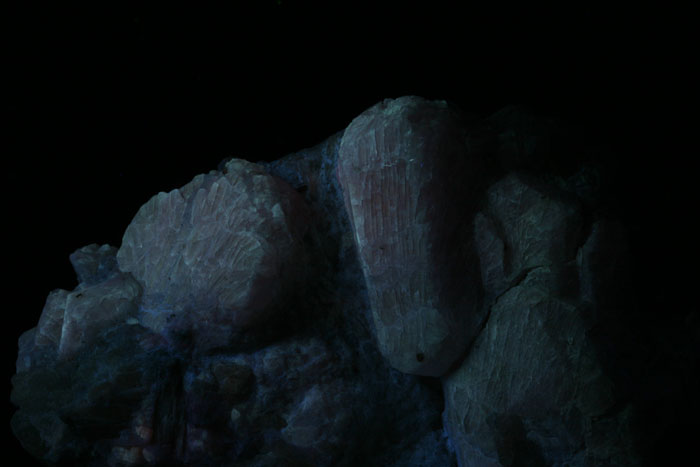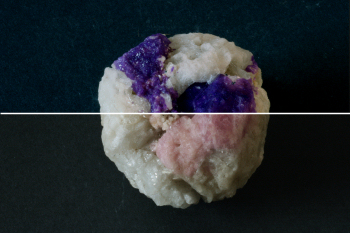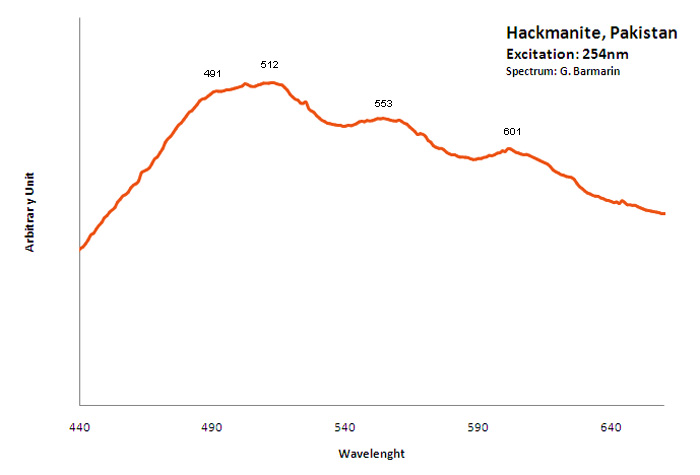Base de données des minéraux luminescents
hackmanite
Formule chimique: Voir SODALITE
Famille: Silicates
Statut: NON APPR
Système cristallin : Cubique
Minéral de vitrine: OUI
Luminescence:
Couleurs UV longs (365nm): |
Orange , Jaune-orange , Rouge orange ("saumon") , | ||
Intensité OL:Forte | Fréquence OL:Toujours | ||
Couleurs UV moyens (320nm): |
Orange , Jaune-orange , | ||
Couleurs UV courts (254nm): |
Jaune-orange , Blanc bleuté , Blanc jaunâtre (crème) , Jaune-orange , Orange , Jaunâtre , | ||
Intensité OC:Moyenne | Fréquence OC: Très souvent | ||
Photo en lumière du jour

Photo Ondes longues (365nm)

hackmanite under UVLW,
Photo and Copyright: James Hamblen
Site of the author
Used with permission of the author
Galerie de photos:


 ...
...  Accès à la galerie complète (24 images au total)
Accès à la galerie complète (24 images au total)
Vous avez une photo de ce minéral que vous voudriez voir figurer dans la galerie? Contactez-nous!
Phosphorescence (au sens commun du terme) observable à l'oeil nu:
Type d'UV |
Couleur |
Intensité |
Fréquence d'observation |
|---|---|---|---|
UV longs (365nm): | Blanc bleuté | Moyenne | UV moyens (320 nm): | Blanc bleuté | Très forte | UV courts (254 nm): | Blanc bleuté | Très forte |
Ténébrescence: OUI

hackmanite, up after and down before exposition to SW (tenebrescence);
Koksha Valley, Badakhshan Province, Afghanistan;
;
Col. G.Barmarin; Photo: G. Barmarin
Thermoluminescence: OUI
Commentaires:
Une variété de sodalite riche en soufre qui n'est pas considérée comme une espèce minérale indépendante.
Activateur(s) et spectre(s):
Activateur(s): S2-,
Pics dans le spectre (nm):
S2- : (566),(610), 625, 647, 664, (695), (723), (751nm)

Col. G. Barmarin; Spectre: G. Barmarin
Galerie de spectres:

 ...
...  Accès à la galerie complète (2 images au total)
Accès à la galerie complète (2 images au total)
Commentaires sur les spectres et les activateurs (*):
O. Ivan Lee investigated what he calls the reversible photosensitivity of hackmanite from Bancroft (Ontario) and his response to different UV sources as early as 1936. He presented the phenomenon for the 50th Anniversary Celebration Banquet of the New York Mineralogical Club, in November 18, 1936 at the American Museum of Natural History. It seems that it was the first observation and the first public announcement and publication (American Mineralogist vol 21) about photochromism (tenebrescence) in mineralogy. Chemical analyses revealed that the mineral contains a certain amount of sulfur as a substitute for chlorine in the crystal structure. The FTIR spectra of hackmanite showed that the samples contain water. The stretching vibration peak of water of crystallization (H2O) occurs at 3438 cm-1 and the bending peak is at 1623 cm-1. Its tenebrescence is caused by hole color centers which are contributed to the presence of sulfur (S2-)) and to some negatively charged chlorine atoms being missing in the crystal structure of hackmanite. (source: http://www.geology.com.cn/Geology-Journals/article-35765.html) Crystals of Hackmanite of Koksha Valley in Afghanistan are usually found in a matrix constituted by non-fluorescing Winchite and/or marble. Synthetic sodalites containing sulfur and showing considerable photochromic activity have been investigated by ESR. The center responsible for the color has been shown to be an electron trapped at a chlorine vacancy. The origin of the electron which is reversibly transferred during the processes of coloration and bleaching is believed to be the ion S2-). (see William G. Hodgson, Jacob S. Brinen, and Emil F. Williams, Electron Spin Resonance Investigation of Photochromic Sodalites, The Journal of Chemical Physics 47, 3719 , 1967)
(*)Les commentaires sur les spectres sont uniquement rédigés en Anglais
Meilleure(s) localité(s) pour la fluorescence (*):
- The Ilímaussaq Complex, Greenland;
- Svintsovyi Ruchei (Lead Creek), Kukisvumchorr Mt, Khibiny Massif, Kola Peninsula, Murmanskaja Oblast, Northern Region, Russia;
- Tawa valley, Kola Peninsula, Murmanskaja Oblast, Northern Region, Russia (type locality);
- Davis Quarry, Dungannon Township, Bancroft District, Hastings Co., Ontario, Canada;
- Poudrette quarry (or Demix or Uni-Mix or Desourdy quarry), Mont Saint-Hilaire, La Vallée-du-Richelieu RCM, Montérégie, Québec, Canada;
- Princess Sodalite quarry and Cancrinite Hill, Bancroft, Canada;
- Ladjuar Medam, Sar e Sang, Koksha Valley, Khash & Kuran Wa Munjan Districts, Badakhshan Province, Afghanistan;
- Kiran, Koksha Valley, Khash & Kuran Wa Munjan Districts, Badakhshan Province, Afghanistan
- Pein-Pyit, Mogok Township, Pyin-Oo-Lwin District, Mandalay Division, Burma (fluo+strong tenebrescence);
- Saga I Quarry Morje Porsgrunn, Sagasen Quarry and Ostskogen Quarry in Tvedalen, Langesundfjord, Larvik Plutonic Complex, Norway;
- Cancrinite Hill, Dungannon Township, Hastings Co., Ontario, Canada (dark blue sodalite dull red fluorescing with yellow cancrinite);
- Tashmarine (diopside) mine, Tien Shan Mountains, Xinjiang Uyghur Autonomous Region, China;
(*)Les données ne sont pas exhaustives et sont limitées à quelques localités remarquables pour la fluorescence
Référence bibliographique pour la luminescence:
- The Henkel Glossary of Fluorescent Minerals, Dr. Gerhard Henkel, Published by the FMS, 1989 ,
- Fluorescence: Gems and Minerals Under Ultraviolet Light, Manuel Robbins, 1994, Geoscience Press, ISBN 0-945005-13-X ,
- The World of Fluorescent Minerals, Stuart Schneider, Schiffer Publishing, 2006, ISBN 0-7643-2544-2 ,
- Ultraviolet Light and Fluorescent Minerals, Th. Warren, S. Gleason, R. Bostwick, et E. Verbeek, 1995, ISBN 0-9635098-0-2 ,
- Minershop.com ,
- Luminescenza nel regno minerale, Guido Mazzoleni, fotografia Roberto Appiani, Libri Sandit, 2010, ISBN 978-88-95990-63-7 ,
- Handbook of Fluorescent Gems and Minerals, a practical guide for the gem and mineral collector, Jack de Ment, 1949 ,
Référence pour la luminescence sur internet:
- Hackmanite as a gemstone
- Poudrette Quarry, Mont St Hilaire, Canada (Mindat.org)
- The Langesundsfjord: history, geology, pegmatites, minerals, Alf Olav Larsen, Bode Verlag Gmbh, 2010 ISBN 978-3-925094-97-2
- Video "Tenebrescence of a Hackmanite cabochon"
- http://rruff.info/uploads/CM21_549.pdf
- A New Property of Matter: Reversible Photosensitivity in Hackmanite from Bancroft, Ontario, O. Ivan Lee, Am. Min, vol 21, 1936
- http://www.geology.com.cn/Geology-Journals/article-35765.html
- https://www.academia.edu/21548029/Laser-induced_time-resolved_luminescence_of_tugtupite_sodalite_and_hackmanite
- Fotochromisme en fluorescentie in sodaliet, variëteit hackmaniet, Geonieuws (MKA) Juni 2010
- MONT-SAINT-HILAIRE, History, Geology, Mineralogy, Laszlo HORVATH, The Canadian Mineralogist, Special Publication 14, 2019
- Photochromism, UV-Vis, Vibrational and Fluorescence Spectroscopy of Differently Colored Hackmanite, November 2023, Crystals 13:1607 DOI:10.3390/cryst13111607
Images:
- Koksha Valley, Afghanistan: http://www.mindat.org/photo-345828.html
- Ontario, Canada: http://www.mindat.org/photo-75890.html
Video:
- Ténébrescence hackmanite & tugtupite : https://www.youtube.com/watch?v=stDh8GDkEYc
- Ténébrescence Hackmanite Mogok : https://www.youtube.com/watch?v=k9B7Omm0nmk
- Ténébrescence hackmanite : https://www.instagram.com/p/BMAb0UWD0nn
Référence minéralogique sur internet:
 http://www.mindat.org/show.php?name=Hackmanite
http://www.mindat.org/show.php?name=Hackmanite
 http://webmineral.com/data/Hackmanite.shtml
http://webmineral.com/data/Hackmanite.shtml
Recherche sur Internet:
 Recherche d'images sur 'Google Image'
Recherche d'images sur 'Google Image'
 Recherche de documents en français sur Google
Recherche de documents en français sur Google
 Recherche de documents en toutes
langues sur Google
Recherche de documents en toutes
langues sur Google
Une requête ne donnant pas de résultat signifie uniquement qu'aucune référence de ce type n'existe dans la base mais en aucun cas qu'elle n'existe pas dans l'absolu. Si vous considérez avoir trouvé une erreur ou une omission, merci de nous le signaler via la page contact en n'oubliant pas de citer la source de l'information.
